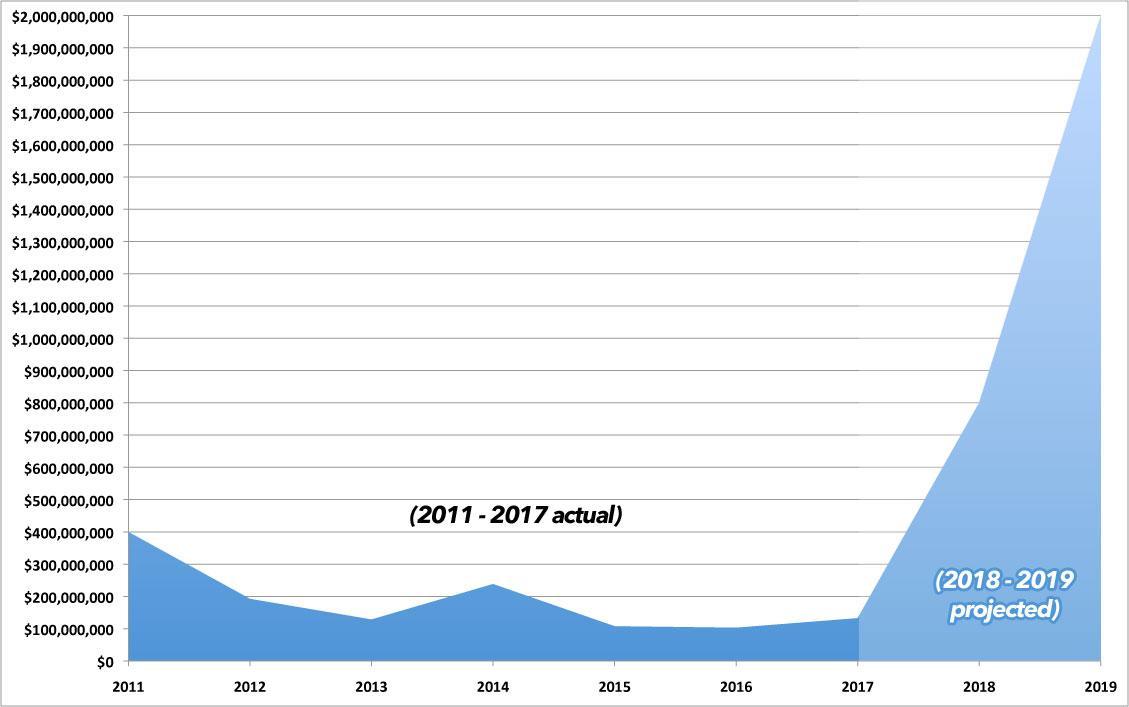Hey, remember when I projected $2.0 billion in ACA indy market MLR rebate payments? Well, guess what!
Last summer, as part of my ambitious Medical Loss Ratio project, I not only broke out the exact dollar amounts and number of enrollees receiving rebates for every insurance carrier in every state in the country before the data was made publicly available, but I even took a crack at projecting just how much I expected individual market MLR rebates to be for every state in 2020 as well.
Historically, the ACA's MLR provision paid out between $100 - $400 million per year from 2012 - 2018 in rebates to individual market enrollees, averaging around $186 million per year...until last year. Here's what I originally projected 2019 payments (paid out in 2020) would likely look like last August:
If you use Anderson's 7% and assume the final, national weighted average for 2020 comes in at around 0.5%, that means roughly 6.5% of that $93.2 billion could end up having to be rebated to enrollees....or potentially 1/3 of up to $6 billion.
The three-year rolling average means that the actual amount paid out would be 1/3 of that...perhaps $2 billion in September 2020.
Some people thought I was nuts to make this projection at the time, and to be fair, this was just a very rough back-of-the-envelope number. When I re-ran the numbers a few weeks later using a ton more hard data, I revised my projection for 2019 MLR rebates (again, to be paid out in August/September 2020) downwards a bit:
When I ran the numbers based on the actual data from 2017 and 2018 and project 2019's MLRs, I ended up with a somewhat smaller (but still massive) potential total for the Individual market: Perhaps $1.7 billion. Not bad, given that the $2 billion figure was complete spitballing. Of course, the $1.7 billion projection is still based on some major assumptions about the 2019 experience; it'll be interesting to see if I end up even remotely close to the actual amounts next August/September.
Well, guess what? via the Kaiser Family Foundation yesterday:
Using preliminary data reported by insurers to state regulators and compiled by Market Farrah Associates, we estimate insurers will be issuing a total of about $2.7 billion across all markets – nearly doubling the previous record high of $1.4 billion last year. The amount varies by market, with insurers reporting about $2 billion in the individual market, $348 million in the small group market, and $341 million in the large group market. These amounts are preliminary estimates, and final rebate data will be available later this year.
Well, now. There you have it.
Kaiser's exact projections for 2019 payments this August are:
- Individual Market: $1.97 billion to 4.74 million enrollees ($420/enrollee on average)
- Small Group Market: $348 million to 189,000 members ($1,850/policyholder on average)
- Large Group Market: $341 million to 2.99 million enrollees ($110/enrollee on average)
- All 3 Markets: $2.66 billion to 7.91 million enrollees/members ($340/enrollee/member on average)
I'm not sure why they're using "members" for the Small Group Market instead of actual enrollees as they do for the other two markets. The official CMS MLR reports for prior years list "consumers benefitting from rebates" (i.e., total enrollees) for all three markets, and the Sm. Group market is nearly 3 million people for 2018 (similar to the 2.3 million in the Lg. Group market). Assuming a similar ~3 million this year, the last line should actually be roughly 10.7 million enrollees averaging around $248 apiece.
In any event, the actual filings won't be available until sometime in mid-August, but unless Kaiser/Mark Farrah Associates are way off, it sounds like my prediction from last year will be dead on target.
One important quirk of the way the MLR rebate program and the ACA APTC subsidy provisions work is that some individual market enrollees will once again end up actually profiting from the MLR rebates. That is, some subsidized enrollees will end up receiving a larger MLR rebate check than the amount they actually paid in premiums last year...in some cases, to the tune of several thousand dollars apiece. And yes, it's all perfectly legal.
I should note that David Anderson also hinted at the massive upcoming MLR rebate payments and how they'll end up effectively paying some people to enroll in subsidized coverage earlier this week.




